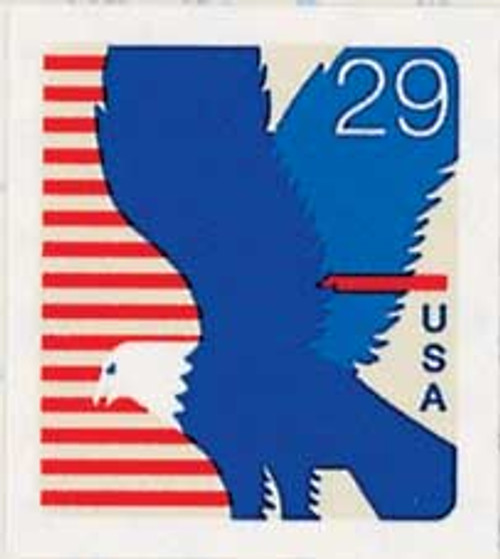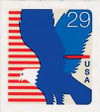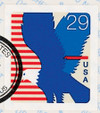
# 2598 - 1994 29c Eagle, self-adhesive
US #2598
1994 Eagle
- One of the first self-adhesive stamps
- Features America’s national bird
Category of Stamp: Definitive
Value: 29¢, First-Class mail rate
First Day of Issue: February 4, 1994
First Day City: Sarasota, Florida
Quantity Issued: 360,000,000
Printed by: National Label Company for 3M
Printing Method/Format: Photogravure. Panes of 18 stamps, from printing cylinders of 486 (18 across, 27 down)
Perforations: Die Cut
Reason the stamp was issued: The Eagle stamp satisfied the First-Class mail rate. The public had been asking for self-adhesive stamps, and this was one of the first to fill that request.
About the stamp design: The colors of this stamp resemble the American flag and picture a bald eagle, America’s national bird. USPS art director Richard Sheaff asked some fellow artists to submit sketches with patriot themes for use on stamps. Robert Brangwynne, a commercial artist offered a sketch of a descending eagle. This became the basis for the stamp design. The subject was stylized and the background was simplified because a new printing company was slated to produce these stamps. The Postal Service wanted an easier image for the company’s first attempt.
About the printing process: The eagle stamp was the start of many self-adhesive stamps. It was issued in a pane of 18 stamps. This was the first stamp to be produced for the Postal Service by 3M.
First Day City: The Eagle stamp was dedicated at the Sarasota national Stamp Exhibition in Sarasota, Florida. The spring meeting of the American Philatelic Society took place in conjunction with the exhibition.
US #2598
1994 Eagle
- One of the first self-adhesive stamps
- Features America’s national bird
Category of Stamp: Definitive
Value: 29¢, First-Class mail rate
First Day of Issue: February 4, 1994
First Day City: Sarasota, Florida
Quantity Issued: 360,000,000
Printed by: National Label Company for 3M
Printing Method/Format: Photogravure. Panes of 18 stamps, from printing cylinders of 486 (18 across, 27 down)
Perforations: Die Cut
Reason the stamp was issued: The Eagle stamp satisfied the First-Class mail rate. The public had been asking for self-adhesive stamps, and this was one of the first to fill that request.
About the stamp design: The colors of this stamp resemble the American flag and picture a bald eagle, America’s national bird. USPS art director Richard Sheaff asked some fellow artists to submit sketches with patriot themes for use on stamps. Robert Brangwynne, a commercial artist offered a sketch of a descending eagle. This became the basis for the stamp design. The subject was stylized and the background was simplified because a new printing company was slated to produce these stamps. The Postal Service wanted an easier image for the company’s first attempt.
About the printing process: The eagle stamp was the start of many self-adhesive stamps. It was issued in a pane of 18 stamps. This was the first stamp to be produced for the Postal Service by 3M.
First Day City: The Eagle stamp was dedicated at the Sarasota national Stamp Exhibition in Sarasota, Florida. The spring meeting of the American Philatelic Society took place in conjunction with the exhibition.








